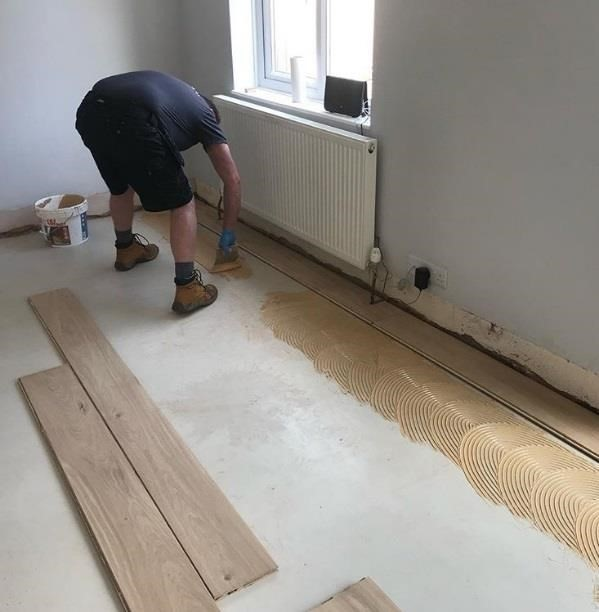
Engineered wood flooring offers a stunning and durable alternative to solid hardwood, making it a popular choice for homeowners. Are you overwhelmed by the various options and unsure where to begin your flooring journey? This thorough guide will equip you with the knowledge you need to confidently select and install engineered wood flooring in your home. We’ll demystify the varied types, explore the pros and cons, and guide you through the installation process, budgeting, and maintenance. By the end, you’ll be ready to transform your living space with beautiful and long-lasting engineered wood floors. Let’s dive in!
Understanding Engineered Wood Flooring
What is Engineered Wood Flooring?
Engineered wood flooring is a multi-layered construction featuring a top layer of real wood veneer bonded to a core of plywood or high-density fiberboard (HDF). This construction offers stability and durability, making it suitable for various climates and subfloors. Unlike solid hardwood, engineered wood is less susceptible to expansion and contraction caused by fluctuating humidity levels. Its structure offers superior resistance to warping and cupping, ensuring the longevity of your flooring.
Types of Engineered Wood Flooring
The industry offers a wide array of engineered wood flooring options, each with its own unique characteristics. The top layer, or wear layer, dictates the durability and aesthetic appeal. Thicker wear layers generally indicate greater resistance to scratches and wear, while the choice of wood species influences the overall look and feel. Popular choices include oak, maple, cherry, and walnut, each offering a distinct grain pattern and color. Consider the thickness of the wear layer and the wood species when making your selection, bearing in mind your lifestyle and budget.
benefits of Engineered Wood Flooring
Engineered wood offers several benefits over solid hardwood. Its dimensional stability makes it ideal for use in basements or areas with higher humidity. The engineered construction outcomes in a more affordable option compared to solid hardwood, without compromising on aesthetics. The ease of installation, especially with click-lock systems, further enhances its appeal to DIY enthusiasts and professional installers alike. Finally, the wide scope of available styles and finishes ensures a perfect match for various interior design preferences.
Choosing the Right Engineered Wood Flooring
Considering Your Lifestyle
Before making a purchase, evaluate your lifestyle and household needs. If you have pets or children, consider a flooring option with a thicker wear layer for enhanced scratch resistance. High-traffic areas might benefit from a harder wood species known for its durability. For instance, oak is renowned for its hardness and resistance to damage, making it a wise choice for bustling households. Conversely, softer woods like cherry might be more suitable for low-traffic areas where aesthetic appeal takes precedence.
Budget Considerations
Engineered wood flooring prices vary considerably depending on factors such as the wood species, wear layer thickness, and finish. Setting a realistic budget early in the selection process will help you narrow down your choices. Remember that high-quality engineered wood is an investment that adds value to your home. Don’t hesitate to compare prices from varied suppliers to find the optimal value for your money. studying varied brands and seeking professional advice from flooring specialists can help make your decision more effective.
Installation Methods
Engineered wood flooring can be installed using various methods, including gluing, nailing, or the increasingly popular click-lock system. The click-lock system simplifies installation, making it a DIY-friendly option. However, for complex installations or large areas, professional assistance might be necessary to guarantee a seamless and flawless finish. Factor in the installation cost when budgeting, considering whether you’ll DIY or hire a professional.
Installation and Maintenance of Engineered Wood Flooring
Preparing the Subfloor
Proper subfloor preparation is paramount to a achievementful engineered wood flooring installation. An uneven or damaged subfloor can lead to problems down the line, such as squeaking or gaps in the flooring. Ensure your subfloor is clean, dry, and level before commencing installation. Consider using a self-leveling compound to address any significant imperfections. Proper preparation ensures the longevity and aesthetic appeal of your new flooring.
Choosing the Right Installer
While DIY installation is possible, especially with click-lock systems, engaging a professional installer offers several benefits. Professionals possess the expertise and tools to ensure a perfect installation, minimizing the risk of mistakes that could affect the longevity and appearance of your floor. They can handle complex situations and guarantee a quality finish. Seek recommendations from friends or family, or review online ratings and reviews before selecting an installer. A reputable installer will offer a warranty for their work, providing peace of mind.
Maintenance and Care
Engineered wood flooring is relatively low-maintenance, but regular care prolongs its lifespan. Regular sweeping or vacuuming removes dirt and debris, preventing scratches. Avoid using excessive water when cleaning, opting instead for a slightly damp mop with a wood-specific cleaner. Place protective mats under furniture legs to prevent scratches and dents. Regularly inspect the flooring for any damage and address it promptly to prevent further problems. Simple maintenance ensures your engineered wood flooring will look amazing for years to come.
Comparing Engineered Wood to Other Flooring Options
Engineered Wood vs. Solid Hardwood
Engineered wood and solid hardwood are both popular choices, but they differ significantly in their construction and properties. Solid hardwood is more expensive and prone to damage from moisture, while engineered wood offers superior stability and resistance to changes in humidity. The choice between them depends on your budget, climate, and lifestyle.
Engineered Wood vs. Laminate
Laminate flooring is a more affordable option but lacks the natural beauty and feel of engineered wood. Laminate is also less durable, although modern laminate offers improvements. Engineered wood is generally superior in terms of aesthetics and longevity, although the boostd cost should be a factor in your decision-making process.
Engineered Wood vs. Luxury Vinyl Plank (LVP)
Luxury vinyl plank (LVP) is a popular and increasingly versatile alternative offering waterproof capabilities and resistance to scratches. However, it lacks the natural aesthetic appeal of engineered wood and might feel less luxurious underfoot. LVP is often a cost-effective choice, particularly in areas prone to moisture.
Finding the optimal Engineered Wood Flooring for Your Home
studying varied Brands
Many reputable brands offer high-quality engineered wood flooring. studying varied brands and reading customer reviews can help you determine options that meet your needs and budget. Look for brands with a strong reputation for quality and customer satisfaction. Reading independent reviews offers insights into the durability, aesthetics, and overall value of varied brands.
Considering varied Finishes
Engineered wood flooring comes in a scope of finishes, including natural, stained, and pre-finished. Each offers a unique look and feel. Natural finishes require more maintenance, while pre-finished options are ready to install and are easy to care for. The choice depends on your aesthetic preference and your willingness to maintain your flooring.
Sourcing and Purchasing
Once you’ve selected the perfect flooring, it’s essential to source it from a reliable supplier. Ensure the supplier has a good reputation and can offer appropriate guarantees and warranties. Compare prices from varied sources to secure the optimal deal. Remember, you’re investing in a long-term solution for your home, so consider the quality and reputation of the supplier.
Choosing the right engineered wood flooring can significantly enhance your home’s beauty and value. Remember the key factors we’ve discussed: understanding the varied types, considering your lifestyle and budget, and selecting a reputable installer. By carefully weighing these facets, you can confidently make an informed decision that will bring years of enjoyment to your space. Don’t hesitate to reach out to flooring professionals for personalized advice and to get started on your engineered wood flooring project today! Your dream floor awaits!
